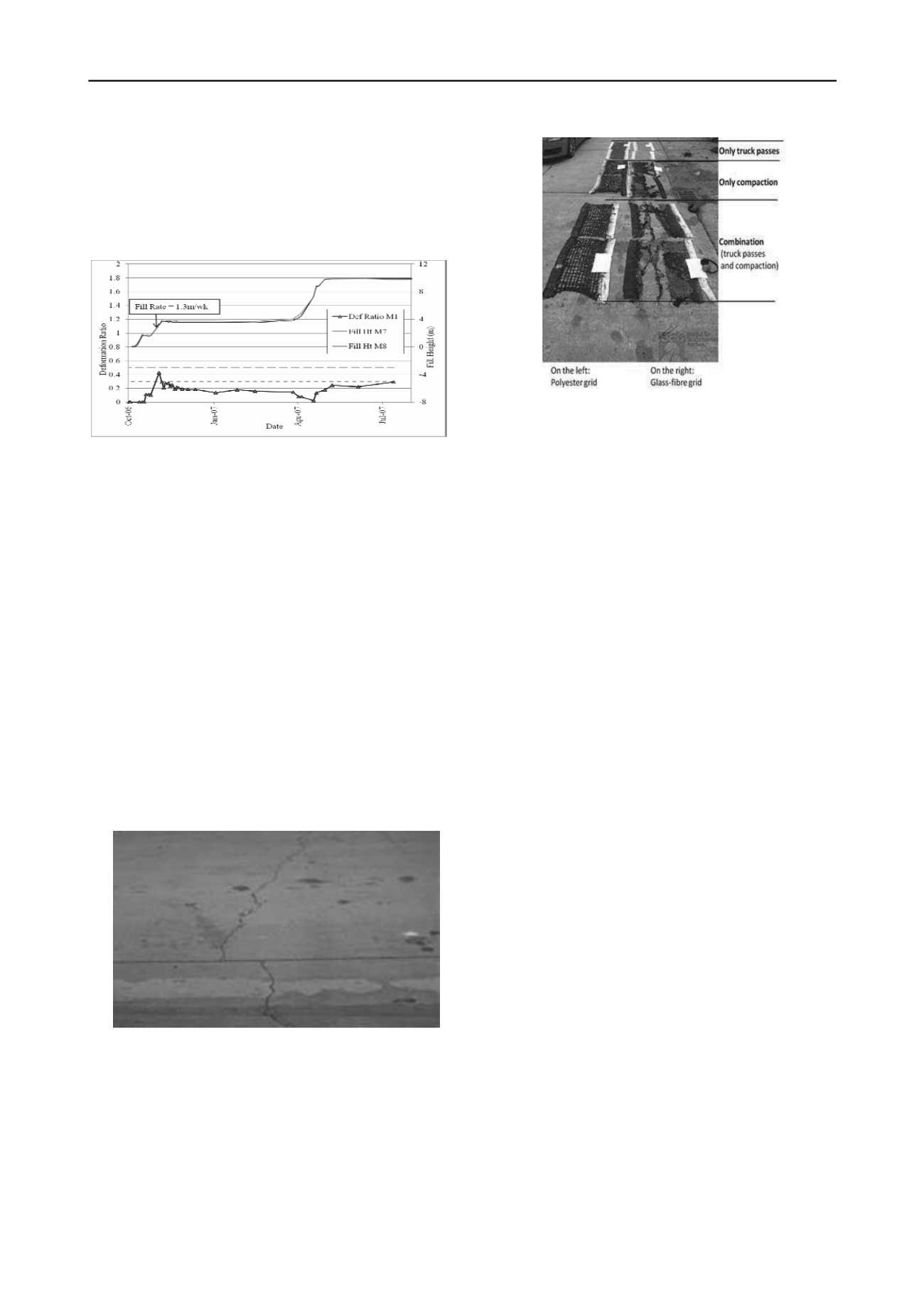
1219
Technical Committee 202 /
Comité technique 202
(PVD), geosynthetic basal reinforcement and 2 to 2.5 m of
surcharge is adopted for ground improvement. A typical filling
rate and deformation ratio history for one of the instrumented
locations is shown in Figure 19. Buggy (2013) concludes that
deformation ratios offer a reliable method for controlling
stability of multi-stage embankments when used in conjunction
with pore pressure instrumentation.
Figure 19. A typical filling rate and deformation ratio history for the
instrumented location at Ch 4+185 m (Source: Fig 2, Buggy 2013).
Murjanto et al. (2013) presented a comprehensive stability
and settlement analysis of the road embankment using a detailed
site investigation. A 7.3 km long embankment with flexible
pavements is built over North Jakarta-soft alluvial deposit. The
pavement level was raised several times in order to compensate
for the settlement. The results of the stability analysis indicated
that the road is relatively in critical condition and some
proposed trial designs were analyzed to fulfill minimum FS by
strengthening of the road embankment using: (i) corrugated
prestressed concrete sheet piles; (ii) corrugated prestressed
concrete sheet piles and horizontal bars; (iii) concrete sheet
piles and ground anchor; and (iv) secant pile walls.
The variation of moisture and mechanical indices on the soil
basement is often neglected while designing concrete
pavements. An interesting study addressing these issues is
reported by Teltayev (2013). He has shown that the sagging,
tensile stress and vertical deformation of the surface of soil
basement are very sensitive to seasonal climate changes. He has
mentioned that design of cement concrete slabs often
incorporate sagging of pavement in spring, however sagging
also increases in summer and autumn seasons and this can be
the cause of various forms of cracks (Figure 20).
Figure 20. Transversal crack in cement concrete pavement (Source: Fig.
8, Teltayev 2013).
In another study by Touole and Thesseling (2013), tensile
strengths of two different asphalt reinforcement products with
different raw materials (polyester and fiberglass) are analysed
considering the influence of installation damage. Results of full-
scale tests after loading from truck passes and asphalt
compaction revealed that the polyester grid undergo a loss of
30% of its tensile strength while the fiberglass grid showed a
loss of strength up to about 90%. The fiberglass grid was
damaged significantly more than the polyester grid
reinforcement (Figure 21).
Figure 21. Results of installation damage test (Source: Fig 5, Touole
and Thesseling 2013).
Solomon et al. (2013) described the performance of shale as
fill and embankment material through laboratory studies and
field trials. In order to reduce costs involved in the hauling of
suitable material over longer distances, possible use of shale is
evaluated. Laboratory tests including index properties,
compaction, California Bearing Ratio (CBR) and triaxial tests
are conducted at six different laboratories and the results,
particularly the CBR values indicated that the shale was of
marginal quality for its intended purposes. However, in a field
trial road section constructed using the shale that was monitored
for a period of two months, the results indicated high CBR and
bearing resistance values with insignificant settlement. The field
performance based characteristics of the shale merited its
selection for use.
3 CONCLUSIONS
The Discussion Session TC202 on Transportation of the 18th
ICSMGE consists of 33 papers (135 pages) describing
numerous efforts on experimental research, field monitoring and
data interpretation, design approaches, analytical methods and
numerical modelling in six distinct categories:
a) Compaction and subgrade improvement
b) Laboratory testing
c) Theoretical advancements and contributions to design
d) Applications of geosynthetics
e) Numerical modelling
f) Field performance evaluation
In this General Report, an attempt has been made to offer a
critical review of the majority of papers that have made a
significant contribution in the area of Transportation, and the
salient aspects of all papers have been summarised in the
Annexure (Tables 2-7). Considering the extensive worldwide
efforts put in by practitioners, academics, research associates
and research students (125 contributors from 19 countries),
there is no doubt that this Technical Session has offered one of
the most comprehensive compilations in Transport Geotechnics,
representing its current state-of-the-art. However, it is noted
that only a limited number of evolving techniques have been
presented to any significant extent, and these include load
transfer analyses including probabilistic approaches, seismic
retrofitting, intelligent compaction control, micro-mechanics of
granular media through DEM modeling, analysis of soil-
geosynthetic interfaces, stabilization of rail and road sub-base
and sub-ballast using geocells, and other ground improvement
methods addressing problematic subgrade, among others. While
some additional papers are cited in this General Report
especially in DEM modeling of granular media, further details
of evolving techniques in Transport Geotechnics have been


